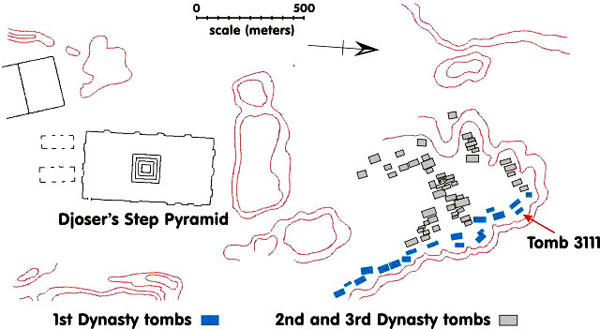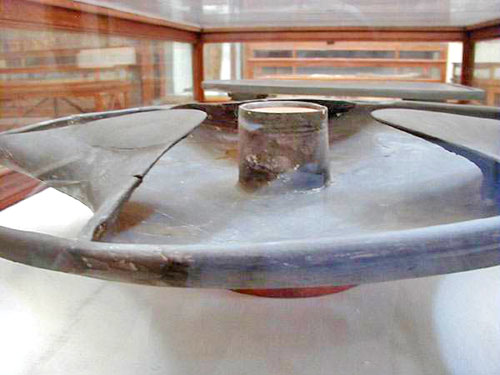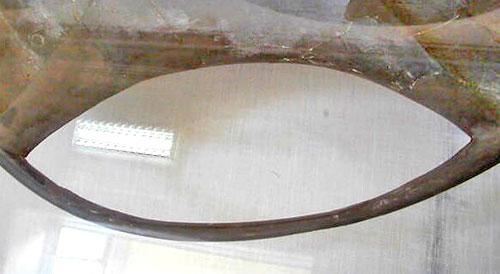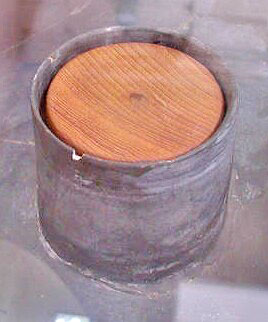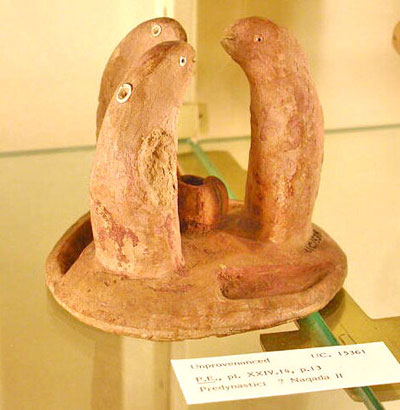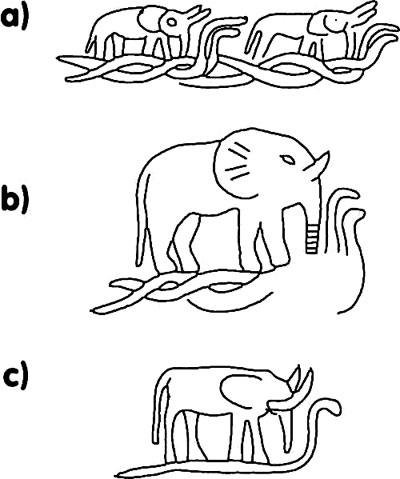|
The Tri-lobed "Schist" Bowl
from
UnforbiddenGeology Website
Introduction
Fig 1. First-Third Dynasty cemetery on the plateau edge of North Saqqara (after
Lehner 1997). General Description of Tomb 3111
In the south corner of the superstructure was located a platform of roughly dressed limestone blocks. Emery (1949) suggests that this is likely a temporary structure possibly used during the funerary ceremony of Sabu. The interior of the mastaba consisted of a seven roomed substructure located in a pit cut to a depth of 2.55 m into the gravel substrate and limestone bedrock (Fig. 2). The rooms were separated by mud brick walls. The mud bricks were made of a dark black earth mixed with straw and averaged about 0.26 by 0.12 by 0.07 meters in size.
Fig 2. Tomb 3111 (after Emery 1949).
Fig 3. Burial chamber of Sabu (after Emery 1949).
Most of the 48 stone vessels in the burial chamber were found broken and
represented 20 different types of stone vessel forms. The material used for
these vessels consisted of travertine (39), metasiltstone (7), and
volcanic
tuff (2). One of the stone vessels was the elaborately designed metasiltstone ornamental tri-lobe bowl (Fig. 4) which was originally found
crushed and scattered around the center of the tomb. The flint implements
consisted of many small knives (85) and a few triangular scrappers (5).
The
Ornamental Tri-lobed "schist" Bowl
Fig. 4. Ornamental bowl from the 1st Dynasty tomb of Sabu (Tomb 3111). (d. 61 cm, Cairo Museum, Photograph by Jon Bodsworth The Egypt Archive)
The vessel consists of a flat, round-bottomed bowl with 3 thinly carved, curved lobes orientated at 120 degrees around the periphery. Very flat and wide bowls are known from the 1st to 3rd Dynasties, but none have been found from the Predynastic Period (El-Khouli 1978). The lobes are separated from the rim by 3 biconvex-shaped perforations (Fig. 5). The center of the vessel contains a thinly carved tube approximately 10 cm in diameter (Fig. 6). When viewed edge on the vessel's flat bowl shape does not show perfect symmetry (Anthony Sakovich personal comm., Fig. 7).
Fig. 5. Biconvex-shaped perforation with tapered rim.
(Cairo Museum,
Photograph by Jon Bodsworth The Egypt Archive)
(Cairo Museum, Photograph by Jon Bodsworth The Egypt Archive) (Cairo Museum, Photograph by Anthony Sakovich Megaliths)
In the past, some Egyptologists have use the term "schist" to describe this artifact (Emery 1949, Aldred 1981); others have identified the object as a slate (Smith 1981). The term schist was not being used in a modern geologic context (i.e. a medium- to coarse-grained foliated metamorphic rock), but was being used to describe a metasedimentary rock called a metasiltstone. This rock is essentially the sedimentary rock siltstone that has been very weakly metamorphosed. It still retains its clastic sedimentary texture and has no visible schistosity. Metasiltstone is similar to slate, but is more coarse-grained and has no fissisity or slaty cleavage, making it a solid rock that does not easily fracture along discreet planes when struck. The weak metamorphism of siltstone indurates the rock and increases the cohesiveness of the mineral grains (i.e. rock hardness), making the rock less susceptible to fracture during carving.
This allows for fine detail and intricate shapes to be carved into vessels, statues, palettes, and other such objects. Metasiltstone as a material for vessel manufacturing came into use during the middle Predynastic and was used extensively during the Early Dynastic Period (Aston 1994). Besides the tri-lobed bowl there are a number of intricately carved metasiltstone objects known from the Early Dynastic, such as a very ornate toilet tray (Fig. 8), flower-shaped vessels (e.g. 1st Dynasty, UC37063 - Note: identified as greywacke but more likely metasiltstone, metagreywacke was not used until the Old Kingdom and not for vessels (Nicholson & Shaw 2000) -, vessels shaped as leaves (e.g. 1st - 2nd Dynasty, UC35653), vessels shaped to imitate basket-work (e.g. 1st - 2nd Dynasty, UC35654), vessels shaped as hieroglyphic symbols (e.g. 1st Dynasty, libation dish), and even used to imitate metal vessels (e.g. a stone vessel with simulated rivet-heads (Lauer 1976, pl. 109). Many of these sophisticated and creative designs are unique to the Early Dynastic Period, showing a high degree of experimentation in artistic expression during this time.
Fig. 8. Metasiltstone ornamental toilet tray and representation of missing center portion (after El-Khouli 1978), 1st Dynasty. (Cairo Museum, Photograph by Jon Bodsworth The Egypt Archive)
Fig. 9. Clay snakes figurine (UC15361) from Nagada II Period. (height 10.5 cm. The Petrie Museum, Photograph by Jon Bodsworth The Egypt Archive)
The use of these early figurines and their religious or magical significance to the ancient Egyptians is not well understood. Animal figurines were often associated with offerings to religious shrines for a variety of early deities. There are a number of Predynastic objects, as well, that depict a close association between snakes (serpents or cobras) and elephants. These snakes either lead or are underneath elephants in a procession (Fig. 10, UC15266), and are often associated with many other animals, including lions, birds, horned oxen, and other quadrupeds. In some examples, these snakes are thought to represent early depictions of the uraeus cobra because of the raised head and neck typical of these species of snakes (Johnson 1990). The horn shaped indentation around the periphery of the clay figurine above may be a simplified representation of an elephant in the form of a tusk-shaped symbol, and 3 associated serpents/cobras leading them in procession.
Although the other Predynastic objects do not depict what the serpents are actually leading the procession of animals to, in the case of the clay figurine above it may be that this is some form of liquid. This liquid may represent a source of water, since snakes during dry seasons are usually found in close proximity to water, and the Nile during inundation usually flushes them out of the area in great numbers. If this is the case, the snakes may be symbolically leading game animals to areas where they can congregate in proximity to water, such as an oasis or the Nile, so that hunting of them could be more easily accomplished. Whether the tri-lobed bowl represents a similar symbolism is uncertain, although the lobes resemble the shapes of serpent/cobras heads in an abstract form, the biconvex shape is common to the representation of intertwined snakes (Fig. 10 a-b), and a central tube suggests a stand for a vessel.
Fig. 10. Late Predynastic urael a) Brooklyn knife handle (c. 3200-3000 BC), b) "Carnarvon" knife handle (c. 3200 BC), c) "Davis" comb handle (c. 3200 BC) (after Johnson 1991).
|
